Scientists in Texas A&M's College Of Geosciences studied thunderstorm changes in the Southern Great Plains with the use of isotopes from Texas cave stalactites.

Oxygen Isotopes
Large thunderstorms in the Southern Great Plains of the United States are some of the most powerful on Earth. In recent years, the frequency and intensity of these storms have increased, and new research reveals that these shifts are linked to climate variability.
Co-authored by Courtney Schumacher, Christopher Maupin, and Brendan Roark, all scientists in Texas A&M University's College of Geosciences, together with other researchers, the discoveries were recently released in Nature Geoscience.
In the study, researchers carried out an analysis on oxygen isotopes from 30,000-50,000-year-old stalactites from Texas caves to have knowledge about trends in early thunderstorms and their durations, making use of radar-based calibration for the region's rainfall isotopes.
Also Read : Powerful Thunderstorms in the Mid-West Can Cause Winds as Strong as Category 2 Hurricane, Forecasters Warn
The Discovery
They found out that when storm regimes move from weakly to strongly organized on millennial timescales, they coincide with familiar, global abrupt climate shifts during the previous glacial period, which took place between about 120,000 and 11,500 years ago.
Through modern-day synoptic analysis, scientists learned that thunderstorms in the Southern Great Plains are strongly linked to changes in wind and moisture patterns taking place at a much larger scale.
Knowing about these changes and different correlations will not only aid in reconstructing past thunderstorm occurrences, but also help in predicting future mid-latitude thunderstorm patterns. Christopher Maupin said: "Proxy records are available in the Southern Great Plains within caves, there are likely thousands of caves in Southern Great Plains and in southern Texas. Why hasn't more research taken place in those places? Cave deposits are so promising as proxies."

Modern-day Rainfall Patterns
Schumacher said researchers have an understanding about modern-day rainfall patterns, and that large storms can deplete isotopes. she said they don't know what will happen in the future, and this work will aid in predicting trends of storms in time to come, and if researchers can run a climate model for the past which is consistent with cave records, and run similar model moving forward, they can trust its discoveries more if it matched the records of the cave versus if they didn't.
Out of two models, if one actually matches the cave isotopes then you can believe that one in understanding storm distribution in the future. Maupin, a paleoclimatologist, made a description of the limitations that exist in capturing the actual distribution of weather events across time.
Schumacher's expertise was required to make connections with different rainfall events that took place over time. She had experience working with radar data and rain measurements on a universal scale.
Audrey Housson '16 and Celia Lorraine McChesney '16 were two undergraduate researchers that were involved in this publication, and both learned a lot through collaboration, field work, and high-impact learning experience.
Related Article: More Than 25,000 Remain Without Power in Rochester Region after Thunderstorms Move Through Area
For more news, updates about thunderstorms and similar topics don't forget to follow Nature World News!
© 2025 NatureWorldNews.com All rights reserved. Do not reproduce without permission.





